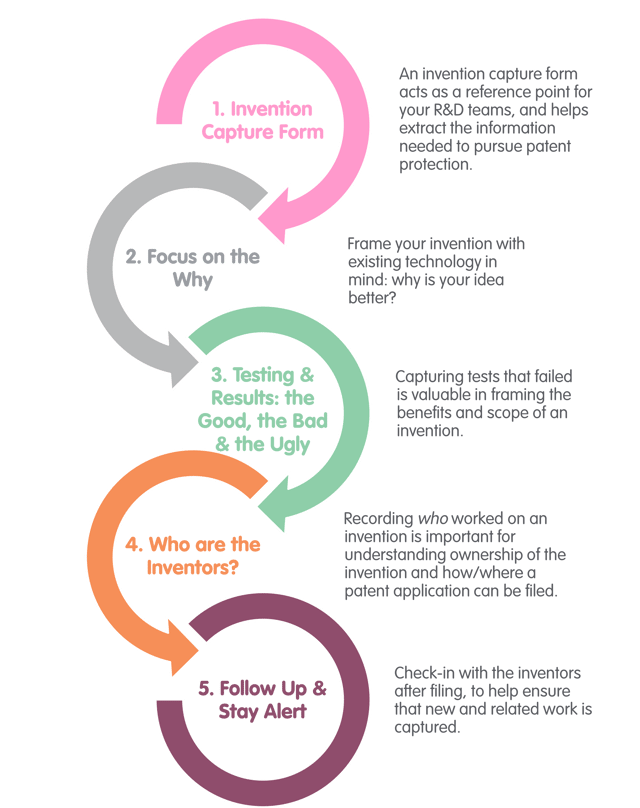Invention capturing, also referred to as invention harvesting or invention mining, is the start of every idea’s journey towards patent protection.
Effective invention capture is essential for innovative companies looking to grow and evolve their patent portfolios.
Whether you’re a start-up, SME, multinational or university, a well-oiled invention capture process can help to increase the number of potential patent filings, while also ensuring the resulting patent applications are commercially relevant and strong.
Here, we discuss five key steps to setting up a successful invention capture process.
The best invention capture is one that’s customised to your needs. We advise on invention capture strategies for all types of organisations at all stages of growth. Get in touch to discuss how we can help with your invention capture process.

1. Invention Capture Form
Invention capture forms allow you to formalise your invention capture process, and act as a reference point for your R&D teams.
Circulating and publicising the form inside your organisation raises awareness of patent protection. Give the form a catchy name, refer regularly to it and the need to complete invention capture forms. Ensure a template is readily available to all technical staff. You will be surprised on the up-take.
Not all ideas will be commercially relevant or patentable. But it’s better to capture more ideas and be selective in the concepts to pursue – rather than missing out on potentially valuable protection.
The invention capture form can set out the information needed to start work on a patent application. Although generic invention capture forms exist, it can be helpful to customise the form for your business – depending on technology area, IP experience and organisation size.
Having an invention capture form is the first step towards embedding invention harvesting into your organisation’s culture.
2. Focus on the Why
Even with an invention capture form in place, it can be difficult to describe an idea. Knowing what to focus on, where to add detail and how to frame your idea can be important for effective invention capture.
A good first step is to think about why you are carrying out the work. What is the problem with existing technology which you’re solving? Why is your idea better than what’s gone before? How does this differ from other work in this area? Why does your solution perform better?
An effective invention capture form can lead you through these questions, and extract the right information. Focusing on what differentiates your work from known technology and why your idea is better is a solid starting point for an invention disclosure.
3. Testing and Results: the Good, the Bad and the Ugly
It is tempting to focus only on the optimised final product or process as your invention. However, the journey needed to reach this optimised variant – failures and all – is an important part of an invention’s story.
Understanding ideas that didn’t work, and tests that failed or performed poorly, is really helpful in preparing a strong patent application. It allows the invention to be framed with the right degree of generality. Understanding all the work you have done helps to pre-empt possible workarounds, and justify a broader scope of protection.
A hard-fought journey also helps tell a compelling story to persuade the patent office of the inventiveness of your idea. Likewise, experimental data from poor tests – often known as “comparative data” – are valuable to evidence the advantages of your own invention.
4. Who are the Inventors?
Recording who worked on an invention, their nationality, country of employment, and where the invention was developed can be essential for understanding ownership of the invention and how/where a patent application can be filed.
Rules around inventorship are complex, and vary depending on country and an inventor’s relationship to an organisation, e.g. if they are an employee, contractor or consultant. Similarly, where a patent application may be filed can depend on where the invention was devised, as well as the nationality of the inventors and applicants.
Recording inventor information early can help get the right documents ready at the right time. A customised invention capture form can help capture the information relevant to your organisation and country.
5. Follow Up and Stay Alert
After a first, “priority” patent application has been filed, there is a one-year period to add additional developments, examples and data to support the application. It’s important to follow up with the inventors periodically to see if any valuable new work is available to add into recent applications.
New work can help support the original concept or may cover related refinements or developments. In any case, it is important to keep all new work confidential until it has been added to a patent application.
Even after the priority filing, it can still be valuable for expected publications, press releases and launches to be reviewed for new material. Regular check-ins with the inventors over the first year can help to ensure that new work is captured.
Niles is a Patent Attorney working in the chemistry field. Niles has an MChem degree in chemistry from the University of Oxford. His undergraduate research project was on the synthesis of novel perylene diimide containing macrocycles for anion recognition and sensing applications.
Email: niles.beadman@mewburn.com

.png)
-Dec-29-2025-09-11-25-2361-AM.png)